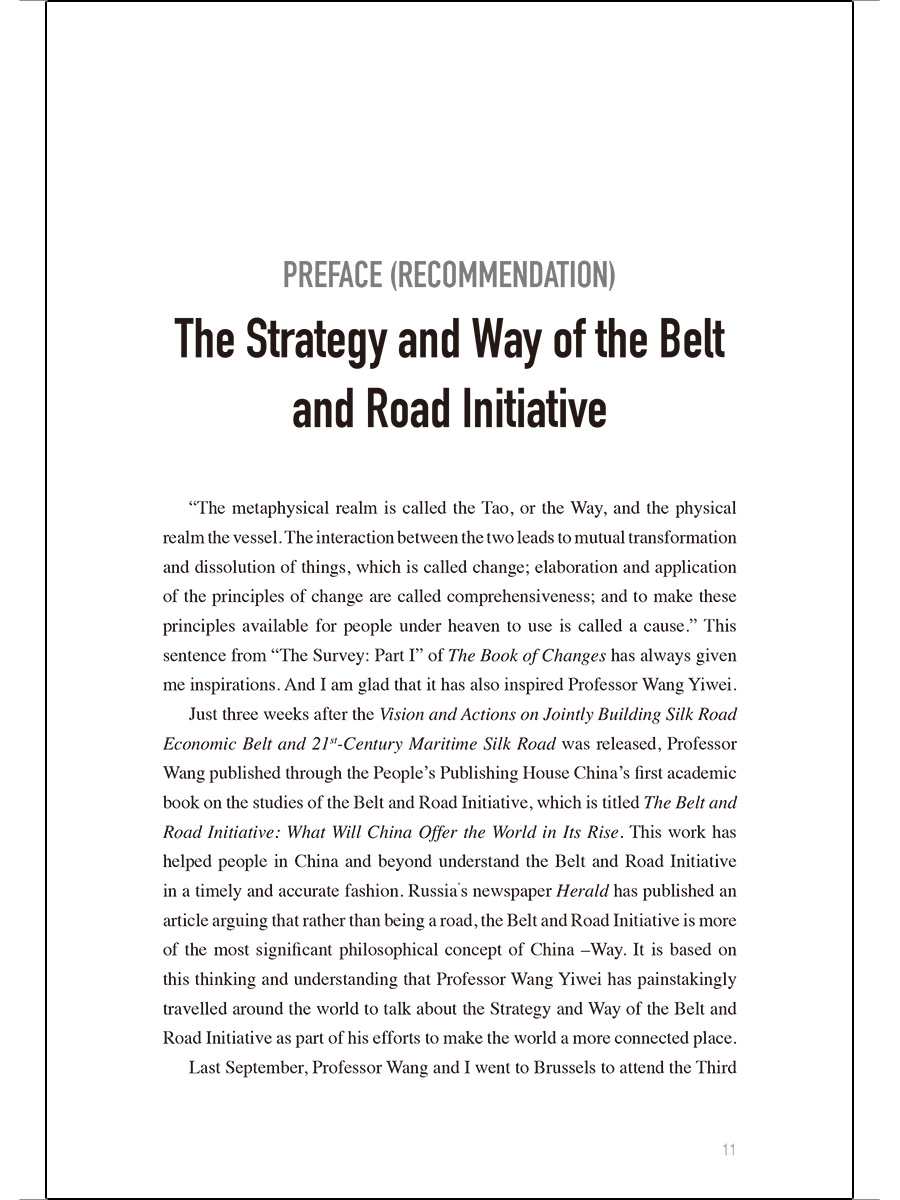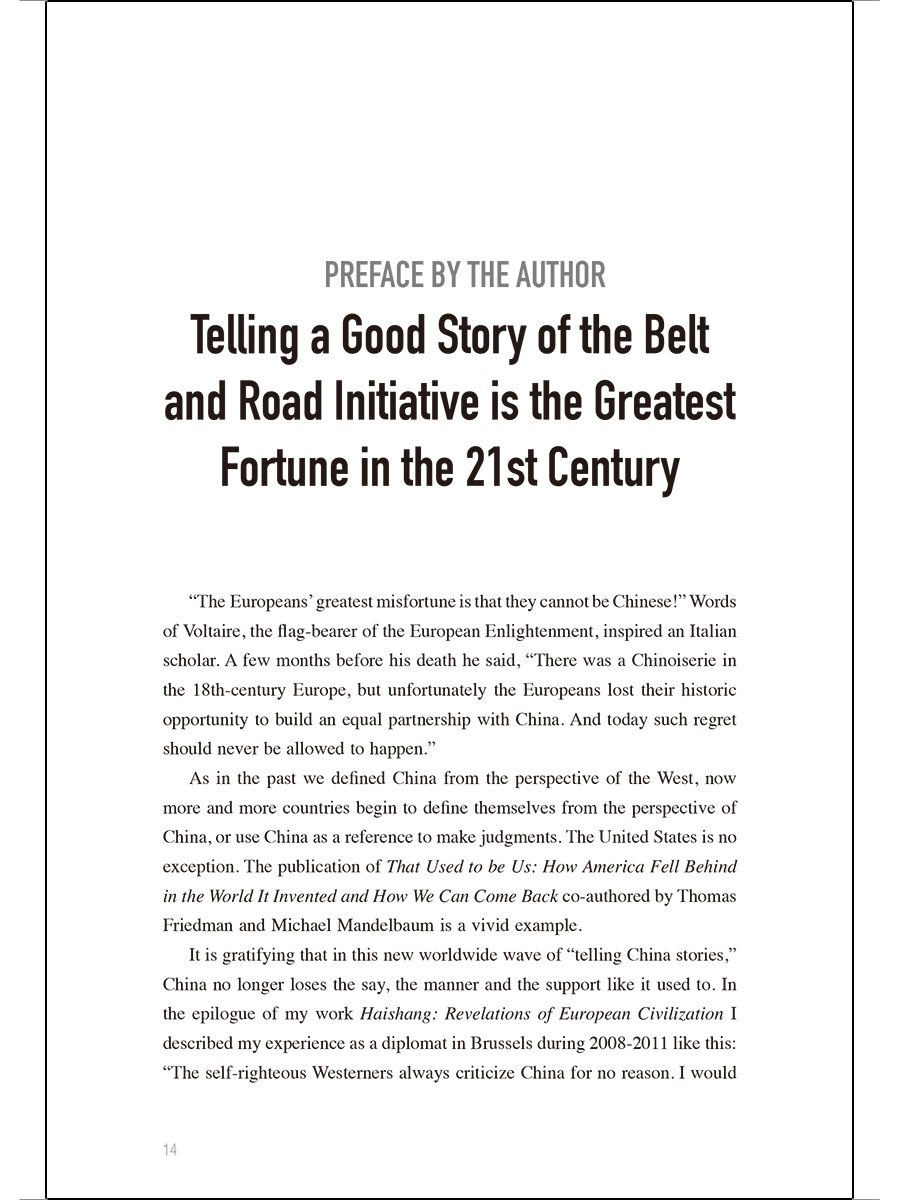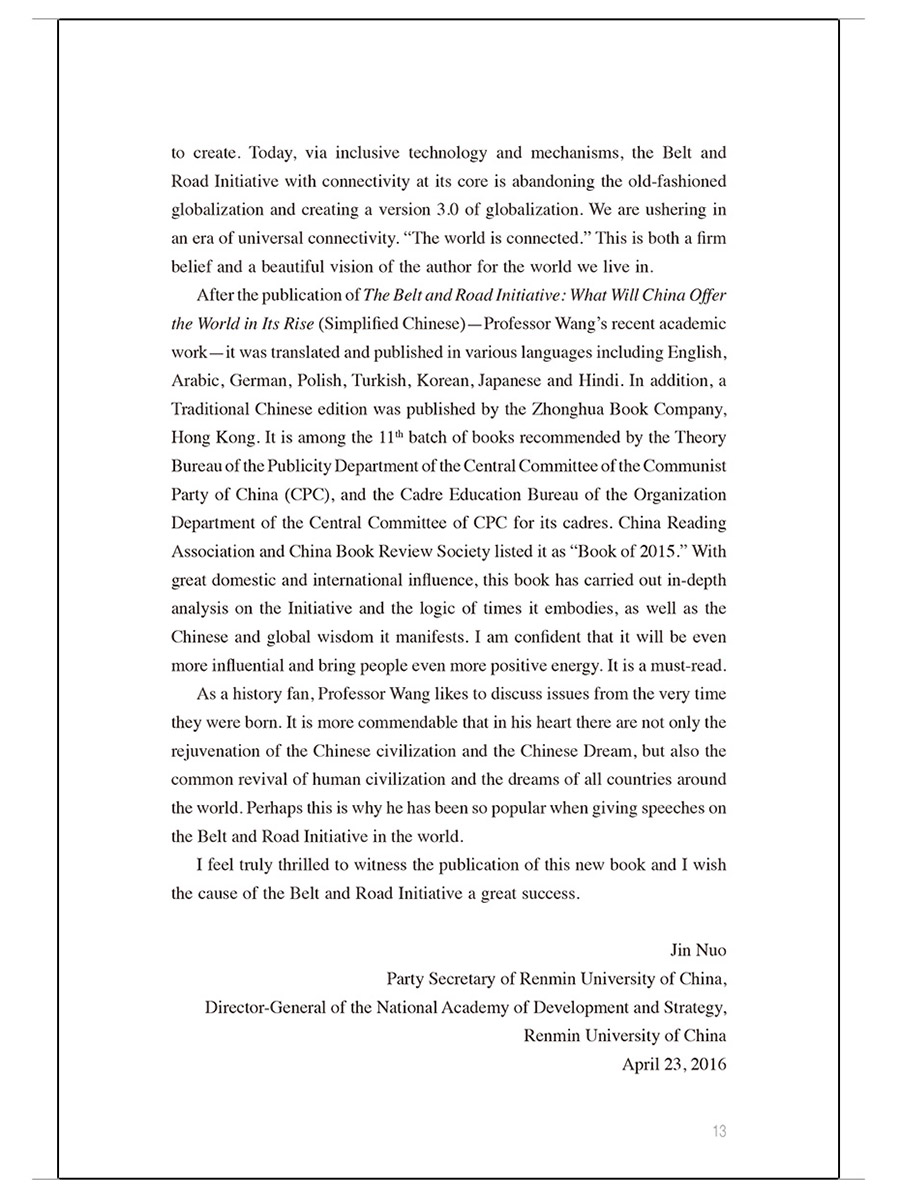
出版社: 五洲传播
原售价: 118.00
折扣价: 70.80
折扣购买: 世界是通的--一带一路的逻辑(英文版)(精)/人大重阳智库作品系列
ISBN: 9787508536262

王义桅,中国人民大学国际关系学院教授,博士生导师,国际事务研究所所长,欧洲问题研究中心/欧盟研究中心研究员、主任,国家发展与战略研究院、重阳金融研究院高级研究员,兼任中联部当代世界研究中心特约研究员,察哈尔学会、春秋发展与战略研究院高级研究员,新疆师范大学及塔里木大学客座教授。先后担任天津联合化学有限公司助理工程师、复旦大学美国研究中心教授、中国驻欧盟使团外交官、同济大学特聘教授。出版专著《一带一路:机遇与挑战》(简体中文、繁体中文、阿、英、韩、德、波、土、印地、日等文版,中宣部理论局、中组部干部教育局向党员干部推荐第十一批学习书目)、《海殇?——欧洲文明启示录》(中英文版)等12部,合著《天命:一种新的领导型国家的诞生》,译著《大国政治的悲剧》等3部;主编“中国北约研究丛书”(10卷本)、《全球视野下的中欧关系》。在《中国社会科学》、《美国政治和社会科学学院年刊》等15个国家学术期刊发表论文200余篇,在《求是》、《人民日报》、《欧洲的世界》等国内外媒体发表时评700余篇,接受CCTV、BBC等国内外媒体采访1000余次,参加博鳌亚洲论坛、香格里拉对话会、慕尼黑安全会议等国际论坛500余次。
The success of the Belt and Road Initiative lies in civilization, in whether our inheritance and innovation concerning the Silk Road civilization can spearhead a new civilization of humanity. The level of the Chinese civilization and the literacy and moral character of the Chinese people determine whether people-to-people bond can be built. Traditional Chinese medicine believes that “If your blood vessels are unimpeded, your pains will be gone. If you still feel painful, they are certainly blocked.” To make the Belt and Road construction unimpeded, the key seemingly lies in economic cooperation. But in essence the competition of development models and logic of civilization hold the key. Here is the Initiative’s three-step strategy for civilization—revival: promote common revival of human civilizations; transformation: bid farewell to modern times and the Western-centered world; innovation: create new human civilizations in the 21st century. 1. Revival of Civilization “Mighty is trend of the world; those who follow it will flourish, while those who act against it will perish.” A century ago, Mr. Sun Yat-sen saw the truth about the world trend and called for the rejuvenation of the Chinese nation. The source of such “linear evolution” is Evolution and Ethics and Other Essays translated by Yan Fu, which combined Darwin’s “theory of evolution” and the Chinese philosophy of “Way of Heaven,” believing that the destiny of the Chinese nation is the integration into the mainstream international community. In fact, as the Heaven is not always a performer of consistency, the evolution of human societies does not equal to progress. The Chinese civilization is the world’s only non-alphabetic civilization that has not been interrupted and colonized by the West. How can its destiny be simply summed up as integration into the major trend of the world? Today, China has gone beyond the era when “Lagging behind leaves one vulnerable to attacks.” In the near future, it will achieve the goal of catching up with the global powers. The Chinese Dream is guided by the revival of civilization rather than the logic of modernization. The modernization started by the West in modern times is competitive. Countries compete with each other in their modernization drive, resulting in rational individuals and irrational collective. This has been too much a burden for the earth and human societies. The reason is that modernization has covered up the commonality of mankind—peace and development, the revival of civilization and the return of human nature. The peace under the logic of modernization is by no means lasting peace, nor is the development common development. The clash of civilizations covered by modernization is even more distressing. In the traditional international system in which nation states are the main unit and international relations dominate how people think, the rise of China has always been viewed as threat. And it’s time for a change. Under the logic of modernization, we focus on GDP but have ignored the environment; we pay attention to technology but have ignored culture; we closely follow the developed countries but have ignored our developing brothers; we repeatedly mention keeping in line with international standards but have ignored the possibility of changing the line; we stress late-mover advantage but have ignored first-mover advantage. The lesson of the Lucky Film indicates that if we only blindly try to catch up with Facebook and Twitter, sooner or later we will fall into disuse. Then why not create something different, like WeChat? For instance, China’s high-speed train is a new miracle of “inclusiveness and connectivity.” The Belt and Road connects the four great ancient civilizations, namely, the Egyptian civilization, Babylon civilization, Indian civilization, and the Chinese civilization. With the integrated multi-dimensional connectivity composed of railways, roads, airlines, maritime routes, oil and gas pipelines, transmission lines and communications networks, the Initiative will promote the revival of inland civilizations and river civilizations, propel the poverty elimination drive of developing countries, and contribute to the successful rise of emerging countries. To be brief, with the logic of civilization revival transcending that of competition in the era of modernization, the Initiative has set the tone for global politics in the 21st century, and justified the Chinese Dream. In the history of human civilization, the Belt and Road Initiative will revise Western-centrism which has made land civilization subject to ocean civilization, and the East to the West, reshape balanced, inclusive globalization, and bring the Eurasian continent back to the center of human civilization. It is a great mission for the Belt and Road Initiative to trigger the grand return of human civilization. First of all, it will bring Eurasia back to the center of human civilization. After the ancient Silk Road was cut off by the “Wall of Ottoman,” Europe turned seaward and ushered in an era of globalization via colonization. Since then, the Oriental civilization became closed and conservative. And the modern world entered an era of Western-centrism. And the rise of the U.S. shifted the center of the West to America. In the meantime, Europe relatively declined, despite all its efforts to unite European countries through establishing the European Community and later the European Union. Today, Europe is witnessing a historic opportunity to return to the center of the world, that is, the revival of the Eurasian continent. The integration of Eurasia, or the World Island, will trigger the strategic effect of making the U.S. an isolated island again, as mentioned in The Grand Chessboard by Zbigniew Brzezinski, and the geopolitical effect of bringing the Eurasian continent back to the center of human civilization, reshaping the world map of geopolitics and globalization. Moreover, it will change the logic for rimland countries to rise in modern times. Since modern times, Portugal, Spain, the Netherlands and the United Kingdom rose from the ocean one after another, and established global hegemony through the great geographical discovery and colonization, until the rise of the U.S. after WWII. However, rather than ancient civilizations that were at the center of human civilization, these European countries were rimland or seaside countries at the margin of the Eurasian continent, the World Island. Therefore, none of their dominance lasted more than 130 years. Promoting the revival of river civilizations and ancient civilizations, the Belt and Road Initiative is changing the modern history in which rimland countries rose, and rectifying the situation where the ocean dominates the land, and the rim dominates the core. As the most important tool of communication and carrier of information, language is the basic element and distinctive logo of culture. It is “the right key to understanding a country.” The rejuvenation of civilization should start with the recovery of linguistic diversity. And the importance of language has become even more prominent with the proposal of the Initiative. The key to Belt and Road construction is the five major goals of connectivity, namely, policy communication, infrastructure connectivity, trade link, capital flow and understanding among people. And the realization of the five goals cannot be possible with language barriers on the way. Language connectivity is both the fundamental guarantee for people-to-people bond and an important underpinning for connectivity building. Roughly, the 65 + countries along the lines speak more than 50 national languages and over 200 languages of different ethnic groups. And most of these languages are non-common languages. For China as a whole to go global, it needs to speak English. But for the Belt and Road construction to really go international, no language works better than local languages. Since the Opium War, the Chinese people were forced to open their eyes and see the world. After China’s reform and opening-up, the world walks into China while China goes global. The proposal of the Belt and Road Initiative indicates that if China wants to involve in global affairs in a more in-depth way, Chinese construction, Chinese service, Chinese model, and the Chinese people in particular, must be something familiar to every family along the routes. From globalization to localization—this is the fundamental cultural logic of the Initiative. 世界是平的,这可能是我们时代最大的错觉。其实,贫富差距、人心不通,乃各国所面临的紧迫挑战;全球化,成为我们时代的想当然。其实,所谓的全球化更多的是沿海地区与发达群体的“部分全球化”(partial globalization)。今天,现代化人口规模从起初欧洲的千万级、美国的上亿级,向新兴国家的几十亿级迈进,单靠欧洲所开辟的航线、美国所确立的规则,早已无法承载。 在这种时代背景下,中国提出“一带一路”伟大倡议,可谓古丝绸之路的中国化、时代化、大众化,堪称第二次地理大发现,体现中国崛起后的天下担当。同时也预示着,文明的复兴而非单向度的全球化才是世界大势所趋。以政策沟通、设施联通、贸易畅通、资金融通、民心相通等“五通”所代表的互联互通,才是塑造人类命运共同体的根本,推动实现真正的“包容性全球化”(inclusive globalization),让全球化普惠而均衡,并落地生根,不仅为中华民族伟大复兴规划路径,而且推动更多国家脱贫致富,开创21世纪地区与国际合作新模式。 本书深入浅出地阐述了“一带一路”时代的全球化、文明、战略、经济、政治、外交逻辑,揭示了“一带一路”倡议所展示的中国智慧与世界智慧,是继作者推出《“一带一路”:机遇与挑战》专著一年后从人类文明史与全球化反思角度研究“一带一路”的力作。



